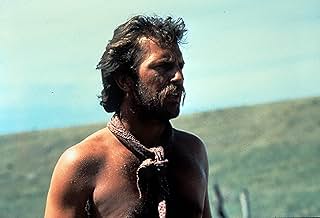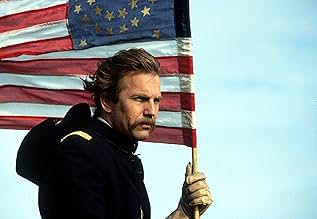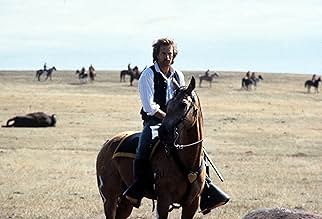Pendant la guerre de Sécession, le lieutenant John Dunbar, affecté à un poste éloigné dans l'Ouest du pays, se lie d'amitié avec les loups et les Indiens. Pour l'armée, ces liens sont inacce... Tout lirePendant la guerre de Sécession, le lieutenant John Dunbar, affecté à un poste éloigné dans l'Ouest du pays, se lie d'amitié avec les loups et les Indiens. Pour l'armée, ces liens sont inacceptables.Pendant la guerre de Sécession, le lieutenant John Dunbar, affecté à un poste éloigné dans l'Ouest du pays, se lie d'amitié avec les loups et les Indiens. Pour l'armée, ces liens sont inacceptables.
- Réalisation
- Scénario
- Casting principal
- Récompensé par 7 Oscars
- 55 victoires et 40 nominations au total
- Ten Bears
- (as Floyd Red Crow Westerman)
Avis à la une
9/10
After having seen this movie again for the first time in years, and after having seen Avatar, it is my opinion that Dances with Wolves is in an entirely different league in terms of story telling. The main ingredients of the story between these two movies is fairly similar - however, the pace and finesse with which Dances with Wolves portrays the development of the relationship between John and the Indians is masterfully done. While Avatar has huge flaws in its story-telling including some scenes with very weak dialogue - it might have gotten away with it as the audience is perhaps distracted by the bombardment of impressive CGI effects!
If you thought Avatar was good and haven't seen Dances with Wolves in a while - I highly recommend it. An excellent move that I think deserves a much better review score - and also should definitely be on IMDBs top 250 list.
2) Sound/Score: the score is one of the best ever written. Again, awards rained from the sky for magical and moving score that combined seamlessly with the film/story.
3) Screenplay: The dialogue and plot is magnificent. The film does not fall into the common plot formulas found in other films that attempt to pass themselves off as epics. The story combines as both of celebration of life and a somber rumination of the history of mankind.
There are comical moments, dramatic moments and tear-jerking moments - that all make their entry (and exit) into the story with flawless timing.
4) The Acting: for all that has been said about Kevin Costner, this was the peak of his career and he played the role of John Dunbar to perfection. A relatively unknown band of actors gave magnificent, heart-felt and down-to-earth performances in support. It was actually refreshing to see an "EPIC" where the producers didn't feel the need to throw famous actors in with cameo roles to improve it marketability. As far as I was concerned, there were no weak links in the chain on the acting side of things. Kevin Costner certainly proved his worthiness as a director by getting the best out of the cast.
5) The ONLY film in history to.... Have an extended (director's cut) version that was better than the original. Due to concerns about the length of the film, Dances with Wolves was stripped back to three hours. Some complained that it was still too long, but I thought that the film was patient - it included good relevant detail but managed to keep the story moving at a good pace. The director's cut added an hour to the cinematic release and was, without a doubt, better than the original. It somehow added more intrigue to the story and included many sobering insights into the destruction of the American Indian race.
Over all, I regard it as the greatest most masterful epic of all time.
This is, simply put, filmmaking of the highest order. Everything magically works in this absolutely engaging 3-hour epic Western. The extended director's cut is an hour longer and most of the added material is worthwhile and fleshes out the characters more than the theatrical cut. I recommend watching the 3-hour version and, if you want more, check out the expanded version.
Over the years I've heard some grumbling about the film's PC-influenced negative portrayal of whites in general and also its supposed romanticized portrayal of Indians as super-virtuous. Hence, before viewing the film again I was braced for the worst. After seeing it, I must say that most of these grumblings are hogwash. No kidding. Really, only a rigid white redneck "patriot" would take offense to this story (and, don't get me wrong, I'm patriotic but not mindlessly so). The film rings of authenticity and the characters are anything but one-dimensional. Want proof? (No major spoilers).
- The Pawnee are the first Indians the viewer encounters in the film and they are portrayed as completely hostile to whites and other NA tribes - so hostile that they'll kill a white person on sight without mercy. I'd say this is a negative, stereotypical portrayal of Indians, wouldn't you agree?
- Also, Wind In His Hair (Rodney A. Grant) clearly states that the Sioux should kill Dunbar at the council meeting; I'm sure there were others who agreed with him but it was ultimately decided that killing Dunbar would likely cause more problems than solve.
- Not all white people are shown in a negative light; in fact, Dunbar himself - the film's protagonist - is white. What about the "foul" guy, Timmons, who escorts Dunbar to the abandoned fort? I've met people just like him. He's not portrayed as evil, but merely uncouth in dress and manners. Anyway, when Timmons gets savagely murdered by a band of Pawnee he begs over and over that the Indians not hurt his mules; his dying words are words of love (for his animals!). Also, when he says goodbye to Dunbar at the fort he says, "Good luck, Lieutenant" and you know he means it; the words show love and respect. Obviously this was a disgusting guy with a heart of gold. Again I know people just like him; it rings of authenticity.
- The story takes place during the Indian Wars where there's very little love & compassion of whites towards Indians and vice versa. The U.S. Army is there to do a job and, as usual, go by the book. Is this a negative portrayal or simply the way it was? The answer is obvious. Hence, most of the officers are not shown in a negative light but merely as military leaders carrying out their duty. Although some of the main enlisted soldiers come off as clueless sheetheads, again, the characters ring of true life. I met people just like 'em in the military.
- Besides, I repeat, not all Natives are depicted as virtuous. The Pawnee are obviously ruthless villains and quite a few Indians are shown helping the U.S. Army and are, therefore, traitors to their people.
- Is the small tribe of Lakota Sioux really super-virtuous? Is their lifestyle really a paradise? No, they're merely portrayed as real people living, pursuing happiness, uncertain about the amassing whites, fighting and persevering through hardships (like the winter camp).
- Is the massive annihilation of Bison (leaving their skinless carcasses to rot in the sun) a negative depiction of whites or just the way it was? Such people would likely shoot a wolf for the "fun" of it. Again, it smacks of reality.
This is just a taste. Clearly, the people in the film are not as one-dimensional as some maintain. Neither is the movie as pro-Indian/anti-white as some insist. It's more complicated than that.
As to the accuracy of the story itself, the fact is that many whites have "gone injun" and many Natives have assimilated with whites. The story explores the possibility of what would happen if a white man dropped all prejudices and tried to get along with some Sioux neighbors; and what if this small band of Natives was open and curious enough to accept him? Is it unlikely that this band would have an available good-looking white woman amongst them that Dunbar could fall in love with? Is there a bit of romanticization? Yes, but it IS a Hollywood movie, after all. Regardless, it's presented in a believable, compelling and captivating way.
"Dances" is almost 20 years old but remains timeless like most great films; it is the definition of why films are made.
The film was shot mostly in Western South Dakota with additional shooting in Jackson, Wyoming, as well as Nebraska and Kansas.
GRADE: A+
"I had never known a people so eager to laugh, so devoted to family, so dedicated to each other. And the only word that came to mind was harmony"
The critics were rubbing their hands with glee, getting ready to tear Costner apart for what undoubtedly would be a failure. An epic Western movie made in 1990, had he not learnt from Heaven's Gate? It was long in production, and with only a $15/$22 million budget afforded it, word came that Costner had to put in $3 million of his own cash to aid production. It was beset with production delays as the problems mounted up with the weather, animal training and with action scenes taking up to three weeks to shoot, all contributing to the belief that it was doomed to failure. "Kevin's Gate" they cried, what's that? It's partially sub-titled too? Never work.
Dances With Wolves went on to make $424 million in Worldwide theatre tickets alone. Heaven knows what the total would be if we added the VHS & DVD returns as well! Come Academy Award time the film won 7 Oscars, including Best Picture (making it the first Western to win the prestigious award since Cimarron in 1931) & Best Director. It was also nominated in five other categories with Costner up for Best Actor, Graham Greene for Best Supporting Actor & Mary McDonnell for Best Supporting Actress. It was, all told, a personal, artistic and commercial triumph for Costner. One can see him post Oscar night sitting there on his porch sipping sour mash and flipping the finger at all those critics who willed him to fail.
Costner's movie is a simple tale, of that there is no arguing. But Dances With Wolves (the name given to Dunbar by the Sioux) is magnificently told, as enchanting a Western that has ever been made. It boasts everything needed to make a first class Oater. The story may be simple but it's rich on detail, the characters have real depth and it never sags, not even in its magnificent elongated directors cut that runs 236 minutes. The credit has to go to Costner, who in his debut as director lest we forget, has managed to blend everything together in the style of one of the old masters from the classic Western period. Every tonal avenue ventured down pays off handsome rewards, it all goes somewhere, awash with wistfulness, romanticism and elegiac poetry. The action sequences are expertly crafted, with a buffalo hunt particularly breath taking; no CGI here, the odd animatronic for a close encounter, but mainly the real deal, as are the wolves and the Lakota Sioux, too, who are played by Native Americans. Its humorous too, with its fun being intentional and aiding the flow of the friendships forming.
As most Western fans will tell you, a lyrical horse opera needs great location work and a score to match. Thankfully Dances With Wolves has both, as both Semler & Barry produce work that picked up the Golden Baldy on Oscar night. Lensed predominantly in South Dakota around the Black Hills & Badlands regions, Semler infuses the film with natural landscapes that send the frontier bursting thru the screen, his framing explains things better than words can in this environment. While Barry's score, lifting nicely from A View To A Kill at times, is suitably grand, deft in touch for the main theme and blood pumping for the buffalo hunt and the Pawnee attacks. Acting wise the award nominations received for Costner, Greene & McDonnell were richly deserved. The boys are quiet and undemonstrative, at one with the essence of the story and infusing it with a sincerity so lacking in many epics. Playing Stands With A Fist, a white woman raised by the Sioux after her family were slaughtered when she was a child, McDonnell has to reach different character levels as the story unfolds, and she delivers emotional depth on every level. No nomination for Grant, but his work is top dollar also, his latter scenes with Costner really nail the shift in tone.
There's some historical missteps that will no doubt annoy the purists, like I don't believe the Pawnee were the aggressors they are painted as here. While the central romance between Costner & McDonnell is delicate but not fully formed; tho it does improve in the directors cut. But it's hard to criticise little itches when such vision and ambition comes together as well as it does here. Structured with precision and showing respect for tradition, this is a movie about loving people for people lovers. And one can quite easily believe that some genre legends up in the sky were looking down and nodding approvingly. 10/10
Oscars Best Picture Winners, Ranked
Oscars Best Picture Winners, Ranked
Le saviez-vous
- AnecdotesBecause of the film's enormous success and sympathetic treatment of the Native Americans, the Lakota Nation adopted Kevin Costner as an honorary member.
- GaffesElectric power lines are visible during the buffalo hunt.
- Citations
Wind In His Hair: [in Lakota; subtitled] Dances with Wolves! I am Wind In His Hair. Do you see that I am your friend? Can you see that you will always be my friend?
- Versions alternativesThe 236-minute "extended version" or "Director's Cut" has been released on home video, altering the movie as such:
- 38 x new scene
- 15 x extended scene
- 12 x alternative footage
- 5 x alternative text
- 1 x new text
- 3 x postponed scene
- 3 x altered arrangement of scenes
- 3 x shortened scene.
- Bandes originalesFire Dance
By Peter Buffett
Meilleurs choix
Détails
- Date de sortie
- Pays d’origine
- Sites officiels
- Langues
- Aussi connu sous le nom de
- Danza con lobos
- Lieux de tournage
- Badlands National Park, Dakota du Sud, États-Unis(Fort Hays to Fort Sedgewick Wagon journey)
- Sociétés de production
- Voir plus de crédits d'entreprise sur IMDbPro
Box-office
- Budget
- 22 000 000 $US (estimé)
- Montant brut aux États-Unis et au Canada
- 184 208 848 $US
- Week-end de sortie aux États-Unis et au Canada
- 598 257 $US
- 11 nov. 1990
- Montant brut mondial
- 424 208 848 $US
- Durée3 heures 1 minute
- Couleur
- Rapport de forme
- 2.39 : 1
Contribuer à cette page



































